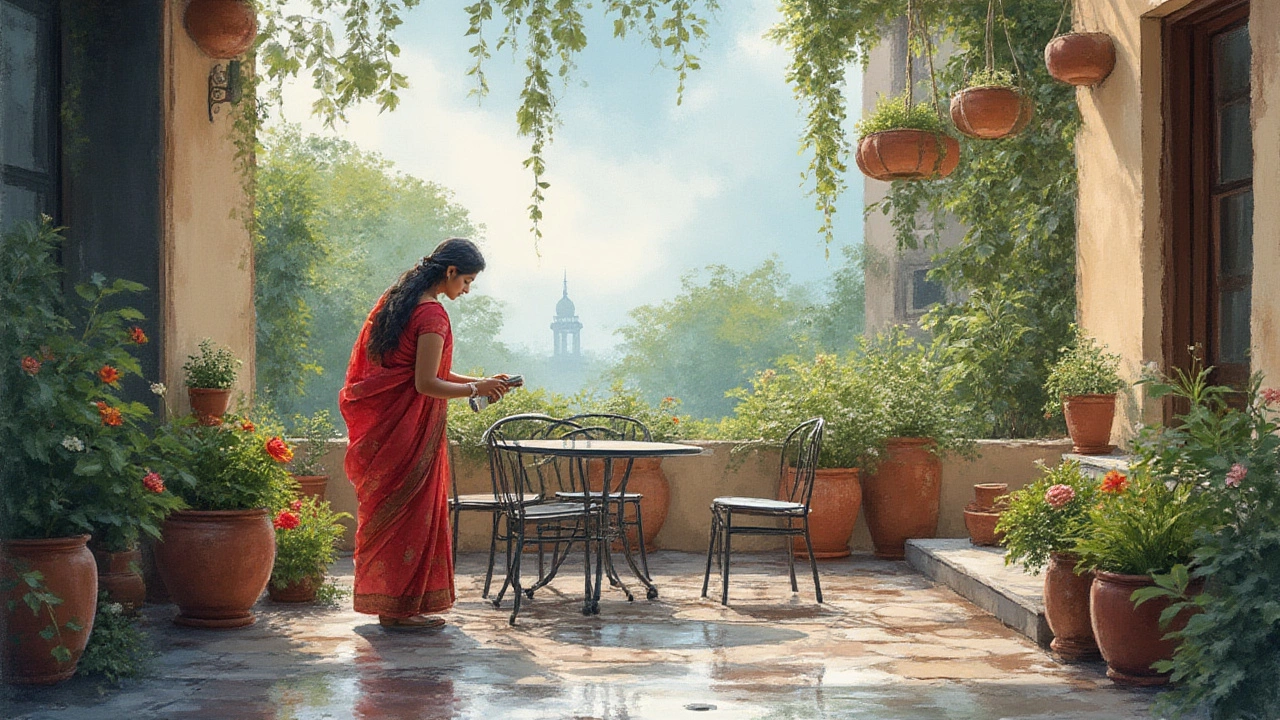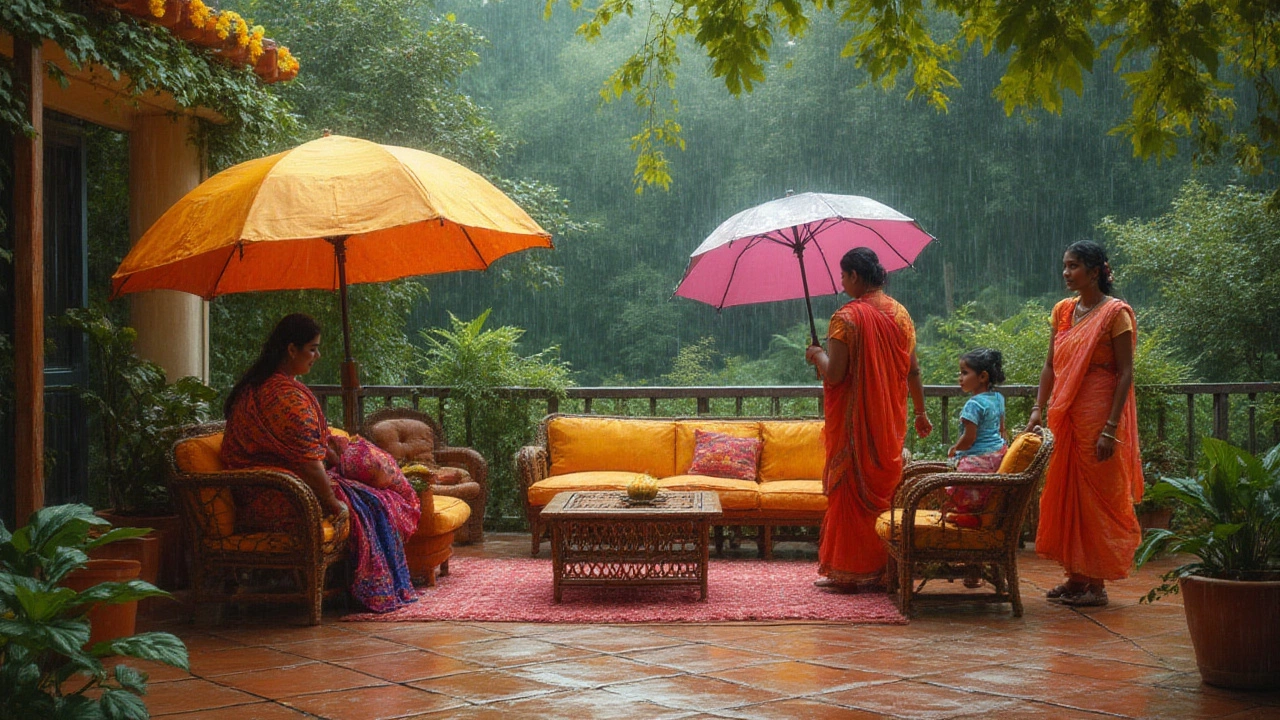Did you know that one heavy rainstorm can shave years off the life of your favourite garden furniture? That plush lounge may look tough, but rain is an expert at creeping into cracks, warping wood, rusting metal, and even turning mildew loose on unsuspecting cushions. Let’s face it: Melbourne’s weather really loves keeping you on your toes. Last autumn, for instance, we clocked a rainy day about every third day. That’s a lot of opportunity for the elements to do their worst. Your outdoor setup probably wasn’t cheap, either—so why let Mother Nature have her way?
Why Rain is Tough on Garden Furniture
Rain sounds lovely when you're inside, but it’s rough on anything exposed to it. Moisture is relentless; it works its way into joints, fibers, bolts, and paints. Take wood for instance: even hardwoods will eventually soak up water if left unprotected. That’s when swelling, splitting, and rotting start. Pine often lasts only a few seasons unless treated, while teak is more resistant but still needs some love. Metals aren’t off the hook, either. Most steel and iron pieces are only one chip in the paint away from rust. Aluminium fares better but can get pitted and dull. Then you have textiles—cushions and seat pads often absorb water like thirsty sponges, leading to mildew, odours, and faded colours.
If you’ve ever returned to find your outdoor table legs sitting in a puddle, you know that excess water can damage glue joints and even cause shifting or wobbly parts. Polyethylene-based wicker might look like it shrugs off wet weather, but over time, UV rays and repeated drenchings can make it brittle. And here’s something not everyone realises: even if your furniture dries quickly, the cycle of wetting and drying stresses most materials and finishes, making them age faster. Outdoor furniture, especially in cities like Melbourne with unpredictable weather swings, gets tested more than you’d think.
Let’s look at the numbers for a moment. A sturdy timber bench, if left exposed without any protection, might last 3-4 years before looking tired and creaky. If you treat, cover, and care for it, that same bench could hold up for a decade or longer. Protection isn’t just about looks—it’s about keeping your investment comfortable, functional, safe, and saving you money in the long run.
The rise of sustainability means more people are choosing recycled materials, but not all modern options outperform old-fashioned timber or metal. Some garden plastic and resin sets lose colour and become brittle after too much sun and rain. A survey by the Australian Furniture Association in 2022 showed that most new buyers regretted skipping protection for their outdoor setups when their gear faded or warped within two years.
So, what causes the most trouble? Constant rain exposure can cause:
- Wood rot and warping
- Rust and paint blisters on metal
- Mildew/mould on fabrics
- Brittleness and colour fading on plastics
- Loose joins and wobbly furniture over time
And the best part? With the right habits and tools, avoiding these problems is easy. Read on and you’ll see how.
Weatherproofing Methods That Really Work
Ready for a deep dive into protection tricks? Not all weatherproofing products or covers are made equal. The first step: know your material. Here’s how to deal with each kind of outdoor furniture:
- Wood: Oils, sealants, and stains are essential. Look for marine-grade varnishes or natural teak oil for hardwoods. Light sanding every few years keeps things smooth before resealing. Wooden legs sitting on pavers? Pop furniture pads underneath so they never sit in water.
- Metal: Rust-proofing spray or car wax works wonders. Examine for nicks and chips in the paint, then touch them up ASAP—don’t wait until rust is visible. Stainless steel is better, but it still likes a gentle wipe-down after storms.
- Plastics & Resin: UV furniture sprays slow down fading, and so do covers. Most plastics need a good clean and dry before storage. Avoid those with foam cores—they keep water inside, which can cause odours.
- Wicker: Synthetic wicker holds up best, but that doesn’t make it invincible. Sprays designed for outdoor furniture repel water and block UV. Repair minor splits with outdoor glue, or they’ll crack further with each wet spell.
- Textiles & Cushions: These need regular protection. Remove and store during heavy weather. Washable covers are a lifesaver, but even ‘water-resistant’ cushions need a few days of sunshine between downpours. Spray-on fabric waterproofers, like those used for tents, work surprisingly well for garden furniture too.
And never, ever underestimate the power of a good cover. Choose thick, waterproof covers with vents to stop condensation. Tie-downs matter—Melbourne winds will steal loose covers in a flash. Don’t settle for those budget tarp-like covers; look for breathable outdoor-rated polyester or PVC blends. Some brands even use weights in the hem to keep the cover grounded.
Data from a CSIRO study in 2023 proved that using high-quality waterproof covers extends the life of outdoor furniture by up to 60%, compared to furniture left exposed. That’s a pretty convincing argument for zipping things up when rain is coming.
Routine makes a difference too. Make a habit of quick wipe-downs after any rain, shake out seat pads, and check for trouble spots every few weeks. Weather apps can be your secret weapon—if heavy rain is in the forecast, stack and cover or move things under shelter, and you’re golden.

Smart Storage and Shelter Solutions
When clouds build on the horizon, quick action can save you heaps of hassle. Nothing beats a proper shelter for garden pieces. Got a garage, shed, or even a spare nook under the eaves? That’s perfect for stacking chairs and storing cushions. Modular outdoor boxes or benches with built-in storage give you an easy weatherproof spot. Choose containers made from water-resistant plastic or composite so you’re not replacing them after a few soggy seasons. Here’s a neat trick: if you don’t have enough inside storage, tilt chairs so water runs off, not in—metal and wooden legs last longer when not standing in puddles.
DIY fans, listen up—a basic canopy or pop-up gazebo can do the trick for those big decks. Look for ones with UV-blocking fabric and corner weights; avoid cheap plastic that tears in a gale. If you’re ready for something more permanent, a retractable awning or pergola changes the game. Most people don’t realise how simple it is to attach a waterproof, UV-rated fabric screen to the open sides of an existing pergola, giving you instant, year-round shade and shelter.
For bigger pieces—think lounge sets or dining tables—consider lightweight waterproof tarps as a last resort, but secure the corners well. Weighted sandbags are better than bricks (which stain pavers). Pair this with a routine once-a-season clean: stack removable parts, let everything dry fully before storing, and label cushion covers so nothing gets misplaced in a rush.
If you’re dealing with space constraints, wall-mounted hooks or shelves are brilliant for storing folded chairs high and dry. And those tall patio heater covers? They double nicely as standing umbrella protectors. Keep an eye out for new products: Melbourne’s homeware shops have loads of clever folds-flat storage boxes popping up each season.
Storage doesn’t have to be expensive, either. Repurposed old chests, laundry baskets with solid lids, or plastic tubs will work for smaller items. Just make sure you’re not trapping in moisture—that’s just inviting mildew.
Quick Fixes, Maintenance, and Clever Prevention Hacks
If the sky suddenly opens up and you haven’t prepped, all is not lost. Mop up standing water right after a shower; a squeegee can clear tabletops in seconds. For soft cushions, press them in a towel to extract as much water as possible, then lean them up on their side in the sun. If a cushion feels heavy or smells musky after a rain, pull the filling out and check for hidden water inside. Sun-dry everything for at least a full day if possible—shadowy corners and under-seat nooks love holding onto damp.
After big storms, it’s worth checking for sneaky issues. Are seat bolts still tight? Any varnish peeling? Tighten screws and dab touch-up paint before small problems turn into big ones. For mildewed fabric, a mix of white vinegar and water usually lifts marks without bleaching most modern outdoor dyes. Just test a hidden spot first.
Smart prevention goes a long way. Place feet pads under metal and wood legs to lift them off the ground. Aim for at least a half centimetre of air space—this simple tweak keeps legs drier and makes cleanup faster. If you’re buying new garden furniture, look for raised feet, larger draining holes, or covers designed for your exact brand and shape. Breathable covers with vent flaps knock out condensation, which can otherwise be as damaging as rain itself.
Routine cleaning is king. Once a month in winter, spray everything down, trim off loose threads, check for early signs of trouble, and keep moving seating arrangements so any spots under chairs actually dry. Want to go even further? Invest in a weather station or smart home sensor that pings you before heavy rain, so you can dash outside and add those final touches of protection.
By putting in a little effort upfront, you’ll get to enjoy your garden setups way longer—and your outdoor barbecues won’t have to compete with soggy chairs or that musty smell that lingers after a storm. Easy? Absolutely. Worth it? Definitely. Here’s a quick table to help you remember what works best for each material:
| Material | Main Rain Hazard | Recommended Protection |
|---|---|---|
| Wood (Teak, Pine, Acacia) | Saturation, rot, warping | Sealant or oil, waterproof cover, raised feet |
| Metal (Steel, Iron, Aluminium) | Rust, corrosion | Rust-proof paint, wax, regular inspections |
| Plastic/Resin | Colour fading, brittleness | UV spray, protective cover |
| Wicker (Natural & Synthetic) | Mildew, UV damage | Spray protector, regular drying |
| Textile/Fabric | Mould, odour, fading | Spray-on waterproofing, indoor storage |
Most people think protecting outdoor furniture from rain is a pain, but when you break it down, it’s just a few quick routines, the right products, and a habit of keeping an eye on the weather. The payoff? You keep your favourite lounging spot comfy, inviting, and looking sharp—rain, shine, or anything in-between. Next time the forecast calls for rain, you’ll know exactly what to do, and your garden setup will stay top-notch, ready for that next sunny weekend gathering.

